With increasing convergence in most markets and intensifying FMC measures, retention is the more promising growth lever for telco operators. Therefore, they need to understand their customers’ changing behavior, especially with regard to churn drivers and inhibitors. Our latest chapter from the Global Telecommunications Study explores this in detail.
The volatile macroeconomic environment has a strong influence on consumer behavior, which telcos must be aware of to keep customers content and retain them in the long run. In the second chapter of our Global Telecommunications Study, we explored peoples’ churn intentions and their experience with telecommunications providers .
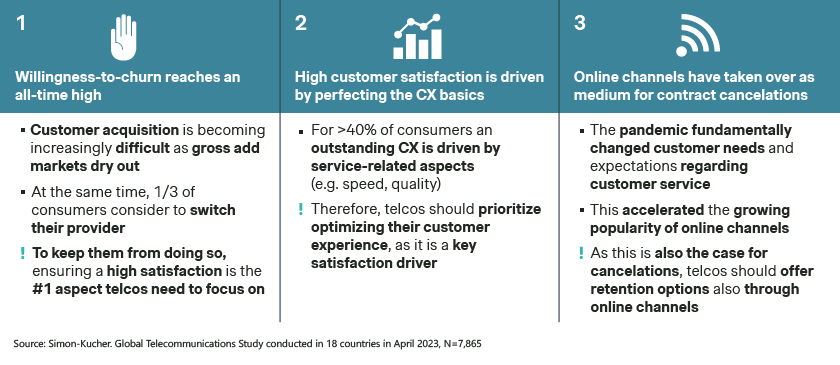
Key insights on current customer behavior and its implications
- Willingness to churn reaches all-time highs:
Our research and experience show that retention is clearly more economical and effective than acquisition. With gross add markets slowly drying out and willingness to churn reaching an all-time high, telcos need to focus on keeping their customer base satisfied. - High customer satisfaction is the number one reason for customers to keep their provider: Roughly 60 percent of broadband and mobile customers indicate that satisfaction is the main reason they don’t consider switching to another provider.
- Improve customer experience to drive satisfaction: Only 50 percent of customer inquiries can be solved during the first call. At the same time, the first call resolution is one of the top criteria in customers’ minds when thinking of an outstanding customer experience (CX). Since high customer satisfaction is a key satisfaction driver, telcos should ensure to constantly perfect their CX basics.
Willingness to churn experiences the highest level in years
Churn intentions have strongly increased in the last year for broadband as well as for mobile services. At present, there are roughly one-third of customers showing interest in changing their provider at the end of the contract period.
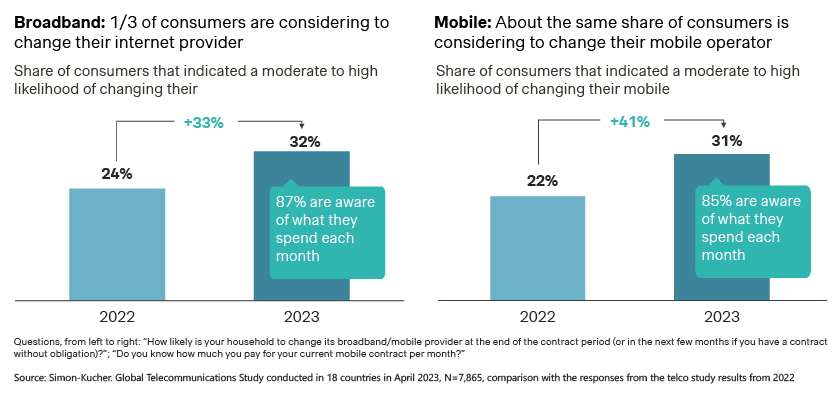
Furthermore, almost 90 percent of customers claim to know their mobile and broadband contract costs each month. This underlines the importance for telcos to plan future portfolio and price adjustments thoroughly to ensure high acceptance.
Timely assessment of churn inhibitors and drivers mitigates churn risk
Maintaining high levels of customer satisfaction is the primary factor in driving customer loyalty: 62 percent of mobile service users and 57 percent of broadband customers stated they were satisfied with their current provider. As the strongest churn prohibitor, assessing the customer satisfaction metrics regularly should be a top priority for telcos.
Meanwhile, providers should aim for their broadband and mobile offerings to be highly differentiated regarding their price points and value-added services. Distinguishing product and service offerings can help to reduce competition since the highest churn motivator was a “good offer from another provider” (17 percent of users).
Next to that, network quality still plays an important role, for both leisure purposes and home office activities. This goes to show that poor network quality continues to be a churn driver even after the pandemic.
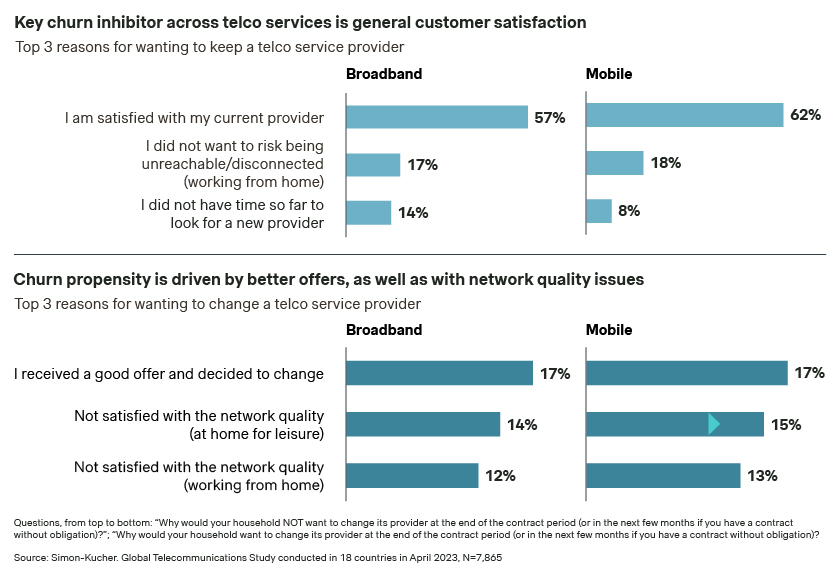
To reduce churn drivers and improve inhibitors where possible, telcos should ensure that customer satisfaction initiatives are continuously tracked.
Perfecting customer experience to achieve higher customer satisfaction
High customer satisfaction is driven by refining the customer experience basics, such as speed, quality, and customer service communication. In fact, simple and quick customer service as well as first contact resolution rank higher than monetary benefits for boosting customer satisfaction.
However, our research finds that only around 50 percent of all cases can be settled during the first customer contact, which shows there is room for improvement and must be addressed. For that, GenAI applications can offer a solution, in combination with improving the skill set of the service agents, as personal interaction will continue to be relevant to certain customer groups.
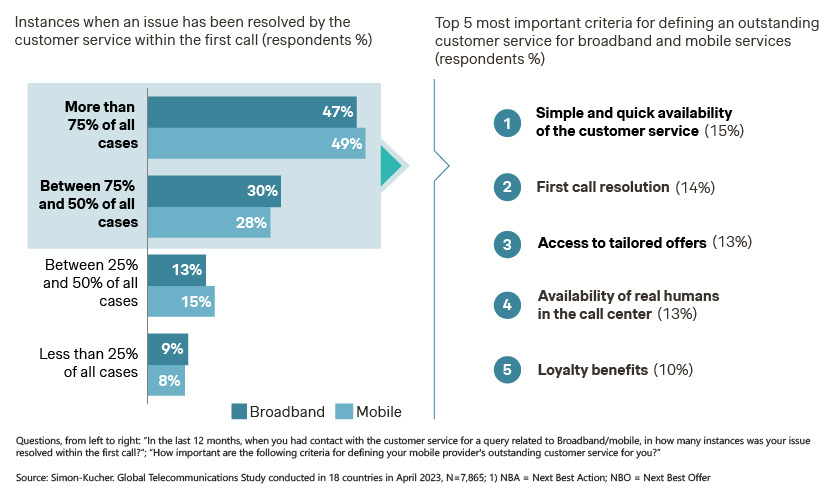
Alternative measures to discounts exist to prevent people from churning
How can telcos prevent customers from churning if they have already decided on it?
According to our results, offering existing tariffs at a lower price can prevent nearly 40 percent of broadband and mobile customer loss.
However, there are other options, like offering value-added services on top for the same price and reviewing the contract and possible new tariffs with a dedicated sales manager. These value-sustaining options offer the possibility to upsell customers depending on their usage behavior.
Majority cancel contracts online – proper digital retention mechanisms need to be available
As digital channels make headway in customer service, this also impacts the cancelation process. Today, around three-fourths of consumers choose to manage their cancelations online. This includes online forms without logging in (20 percent), pre-filled online forms with login (18 percent), through mobile apps (17 percent), online chats (13 percent), or via e-mail (nine percent).
The other one in four customers that still prefers offline channels mostly use the hotline (17 percent) while only a minor share of customers use letters (three percent) and faxes (two percent).
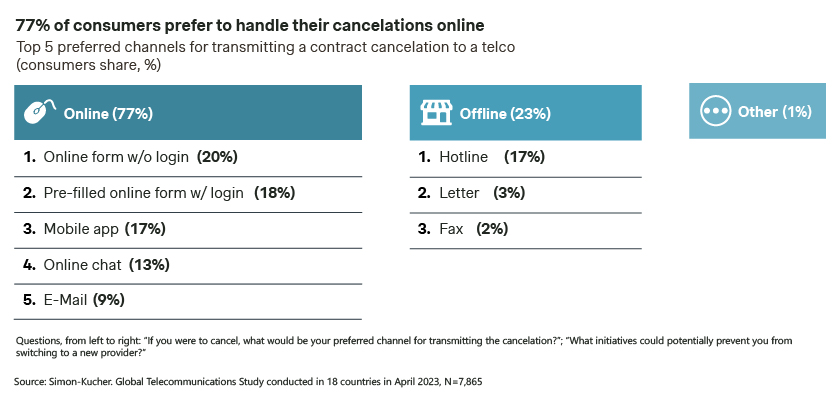
Based on these results, telcos need to develop proactive retention mechanisms across channels to address customers with attractive offerings.
Simon-Kucher’s customer experience maturity framework
Telcos need to improve their customer experience continuously through a broad range of initiatives. At Simon-Kucher, we have developed a dedicated CX maturity framework set up in six levers that should all be addressed when planning and tracking these initiatives accordingly.
Read part one of our 2023 Global Telecommunications Study here : For more information, reach out to our industry experts.








